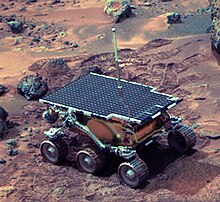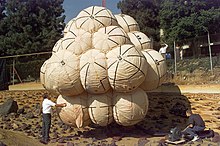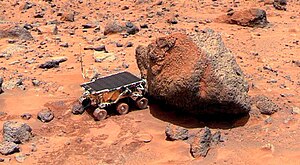Mars Pathfinder (MESUR Pathfinder[1]) was an American spacecraft that landed a base station with roving probe on Mars in 1997. It consisted of a lander, renamed the Carl Sagan Memorial Station, and a lightweight (10.6 kilograms/23 pounds) wheeled robotic rover namedSojourner.[2]
Launched on December 4, 1996 by NASA aboard a Delta II booster a month after the Mars Global Surveyor was launched, it landed on July 4, 1997 on Mars' Ares Vallis, in a region called Chryse Planitia in the Oxia Palus quadrangle. The lander then opened, exposing the rover which conducted many experiments on the Martian surface. The mission carried a series of scientific instruments to analyze the Martian atmosphere,climate, geology and the composition of its rocks and soil. It was the second project from NASA's Discovery Program, which promotes the use of low-cost spacecraft and frequent launches under the motto "cheaper, faster and better" promoted by the then administrator, Daniel Goldin. The mission was directed by the Jet Propulsion Laboratory (JPL), a division of the California Institute of Technology, responsible for NASA'sMars Exploration Program. The project manager was JPL's Tony Spear.
This mission kicked off a series of missions to Mars that included rovers, and was the next successful lander since the two Vikings landed on the red planet in 1976. Although the Soviet Union successfully sent rovers to the Moon as part of the Lunokhod program in the 1970s, its attempts to use rovers in its Mars probe program failed.
In addition to scientific objectives, the Mars Pathfinder mission was also a "proof-of-concept" for various technologies, such as airbag-mediated touchdown and automated obstacle avoidance, both later exploited by the Mars Exploration Rovers. The Mars Pathfinder was also remarkable for its extremely low price relative to other unmanned space missions to Mars. Originally, the mission was conceived as the first of the Mars Environmental Survey (MESUR) program.
Mission objectives
- To prove that the development of "faster, better and cheaper" spacecraft was possible (with three years for development and a cost under $150 million).
- To show that it was possible to send a load of scientific instruments to another planet with a simple system and at one fifteenth the cost of a Viking mission. (For comparison, the Viking missions cost $935 million in 1974[3] or $3.5 billion in 1997 dollars)
- To demonstrate NASA's commitment to low-cost planetary exploration by finishing the mission with a total expenditure of $280 million, including the launch vehicle and mission operations.
[edit]Science experiments
The Mars Pathfinder conducted different investigations on the Martian soil using three scientific instruments. The lander contained a stereoscopic camera with spatial filters on an expandable pole called Imager for Mars Pathfinder (IMP),[4][5] and the Atmospheric Structure Instrument/Meteorology Package (ASI /MET)[6] which acts as a Mars meteorological station, collecting data about pressure, temperature, and winds. The MET structure included three windsocks mounted at three heights on a pole, the topmost at about one meter (yard) and generally registered winds from the West.[7] The IMP camera'sspatial resolution depended on the distance of the imaged region.[8]
The Sojourner rover had a Alpha Proton X-ray Spectrometer (APXS),[9] which was used to analyze the components of the rocks and soil. The rover also had two black-and-white cameras and a color one. These instruments could investigate the geology of the Martian surface from just a few millimeters to many hundreds of meters, the geochemistry and evolutionary history of the rocks and surface, the magnetic and mechanical properties of the land, as well as the magnetic properties of the dust, atmosphere and the rotational and orbital dynamics of the planet. The rover had two black & white 0.3-megapixel cameras on the front (768 horizontal pixels × 484 vertical pixels configured in 4 × 4 pixel blocks), coupled with five laser stripe projectors, which enabled stereoscopic images to be taken along with measurements for hazard detection on the rover's path. On the back, near the APXS and rotated by 90°, there was a third camera of the same specifications which supported taking colour images. This back colour camera provided images of the APXS's target area and the rover's tracks on the ground, and had sensitivity to green (12 pixels out of the 16 total pixels in each 4 × 4 pixel block), red (2 pixels), and blue (2 pixels), with the blue-sensitive pixels being sensitive to infrared as well. However, all cameras had zinc-selenide lens which blocked blue light below 500 nm, thus only allowing infrared wavelengths to reach the blue pixels. All three cameras were CCDs manufactured by Eastman Kodak Company, and were controlled by the rover's CPU. They all had auto-exposure and bad pixel handling capabilities, and the image parameters (exposure time, compression used, etc.) were included in the transmitted images as part of theimage header. The rover could compress the front cameras' images using the block truncation coding (BTC) algorithm, but it could only do the same for the back camera's images if the colour information was discarded. The cameras' optical resolution was sufficient for resolving 0.6 cm details across a 0.65 m range.[8]
[edit]Pathfinder lander
- Imager for Mars Pathfinder (IMP), (includes magnetometer and anemometer)
- Atmospheric and meteorological sensors (ASI/MET)
[edit]Sojourner rover
- Imaging system (three cameras: front B&W stereo,[8] 1 rear color)
- Laser striper hazard detection system
- Alpha Proton X-ray Spectrometer (APXS)
- Wheel Abrasion Experiment
- Material Adherence Experiment
- Accelerometers
[edit]Landing site
The landing site was an ancient flood plain in Mars's northern hemisphere called "Ares Vallis" ("the valley of Ares," the ancient Greek equivalent of the ancient Roman deity Mars) and is among the rockiest parts of Mars. Scientists chose it because they found it to be a relatively safe surface to land on and one that contained a wide variety of rocks deposited during a catastrophic flood. After the landing, at 19.13°N 33.22°WCoordinates: 19.13°N 33.22°W,[10] succeeded, the landing site received the name The Carl Sagan Memorial Station in honor of the late astronomer.
[edit]Entry, descent and landing
Mars Pathfinder entered the Martian atmosphere and landed using an innovative system involving an entry capsule, a supersonic parachute, followed by solid rockets and large airbags to cushion the impact.
Mars Pathfinder directly entered Mars atmosphere in a retrograde direction from a hyperbolic trajectory at 6.1 km/s using an atmospheric entry aeroshell (capsule) that was derived from the original Viking Mars lander design. The aeroshell consisted of a back shell and a specially designed ablative heatshield to slow to 370 m/s (830 MPH) where a supersonic disk-gap-band parachute was inflated to slow its descent through the thin Martian atmosphere to 68 m/s (about 160 MPH). The lander's on-board computer used redundant on-board accelerometers to determine the timing of the parachute inflation. Twenty seconds later the heatshield was pyrotechnically released. Another twenty seconds later the lander was separated and lowered from the backshell on a 20 m bridle (tether). When the lander reached 1.6 km above the surface, a radar was used by the on-board computer to determine altitude and descent velocity. This information was used by the computer to determine the precise timing of the landing events that followed.
Once the lander was 355 m above the ground, airbags were inflated in less than a second using three catalytically cooled solid rocket motors that served as gas generators. The airbags were made of 4 inter-connected multi-layer vectran bags that surrounded the tetrahedron lander. They were designed and tested to accommodate grazing angle impacts as high as 28 m/s. However, as the airbags were designed for no more than about 15 m/s vertical impacts, three solid retrorockets were mounted above the lander in the backshell. These were fired at 98 m above the ground. The lander's on-board computer estimated the best time to fire the rockets and cut the bridle so that the lander velocity would be reduced to about 0 m/s between 15 and 25 m above the ground. After 2.3 seconds, while the rockets were still firing, the lander cut the bridle loose about 21.5 m above the ground and fell to the ground. The rockets flew up and away with the backshell and parachute (they have since been sighted by orbital images). The lander impacted at 14 m/s and limited the impact to only 18 G of deceleration. The first bounce was 15.7 m high and continued bouncing for at least 15 additional bounces (accelerometer data recording did not continue through all of the bounces).
The entire entry, descent and landing (EDL) process was completed in 4 minutes.[11]
Once the lander stopped rolling, the airbags deflated and retracted toward the lander using four winches mounted on the lander "petals". Designed to right itself from any initial orientation, the lander happened to roll right side up onto its base petal. 74 minutes after landing, the petals were deployed with Sojourner rover and the solar panels attached on the inside.
The lander arrived at night at 2:56:55 Mars local solar time (16:56:55 UTC) on July 4, 1997. The lander had to wait until sunrise to send its first digital signals and images to Earth. The landing site was located at 19.30° north latitude and 33.52° west longitude in Ares Vallis, only 19 kilometres southwest of the center of the 200 km wide landing site ellipse. During Sol 1 –or martian days– the lander took pictures and made some metereologic measurements. Once the data was received, the engineers realized that one of the airbags hadn't fully deflated and could be a problem for the forthcoming traverse of Sojourner's descent ramp. To solve the problem, they sent commands to the lander to raise one of its petals and perform additional retraction to flatten the airbag. The procedure was a success and on Sol 2, Sojourner was released, stood up and backed down one of two ramps.
The Mars Pathfinder entry descent and landing system design was used (with some modification) on the Mars Exploration Rover mission. Likewise, many design aspects of the Sojourner rover (e.g. the rocker-bogie mobility architecture and the navigation algorithms) were also successfully used on the Mars Exploration Rover mission.
[edit]Rover operations
[edit]Sojourner deployment
The Sojourner rover was the second space exploration rover to reach another planet, and the first to be deployed. Sojourner's exit from the lander occurred on Sol 2, after its landing on July 4, 1997. As the next sols progressed it approached some rocks which were named (by the scientists) "Barnacle Bill", "Yogi", and "Scooby Doo", after famous cartoon characters. The rover made measurements of the elements found in those rocks and in the martian soil, while the lander took pictures of the Sojourner and the surrounding terrain, besides making climate observations.
The Sojourner is a six-wheeled 65 cm long vehicle, 48 cm wide, 30 cm tall and weighs 10.5 kg.[12] When operating, it could move about 500 meters from the lander and its maximum speed reached one centimeter per second. During its 83 sols of operation, it sent 550 photographs to Earth and analyzed the chemical properties of 16 locations near the lander.
[edit]Sojourner's rock analysis
The first analysis on a rock started on Sol 3 with Barnacle Bill. The Alpha Proton X-ray Spectrometer (APXS) was used to determine its composition, the spectrometer taking ten hours to make a full scan of the sample. It found all the elements except hydrogen, which constitutes just 0.1 percent of the rock's or soil's mass.
The APXS works by irradiating rocks and soil samples with alpha particles (helium nuclei, which consist of two protons and two neutrons). The results indicated that "Barnacle Bill" is much like Earth's andesites, confirming past volcanic activity. The discovery of andesites shows that some Martian rocks have been remelted and reprocessed. On Earth, Andesite forms when magma sits in pockets of rock while some of the iron and magnesium settle out. Consequently, the final rock contains less iron and magnesiums and more silica. Volcanic rocks are usually classified by comparing the relative amount of alkalis (Na2O and K2O) with the amount of silica (SiO2). Andesite is different than the rocks found in meteorites that have come from Mars.[13][14][15]
Analysis of the Yogi rock again using the APXS showed that it was a basaltic rock, more primitive than Barnacle Bill. Yogi's shape and texture show that it was probably deposited there by a flood.
Another rock, named Moe, was found to have certain marks on its surface, demonstrating erosion caused by the wind. Most rocks analyzed showed a high content of silicon. In another region known as Rock Garden, Sojourner encountered crescent moon-shaped dunes, which are similar to crescentic dunes on Earth.
By the time that final results of the mission were described in a series of articles in the journal Science (December 5, 1997), it was believed that the rock Yogi contained a coating of dust, but was similar to the rock Barnacle Bill. Calculations suggest that the two rocks contain mostly the minerals orthopyroxene (magnesium-iron silicate), feldspars (aluminum silicates of potassium, sodium, and calcium), quartz (silicon dioxide), with smaller amounts of magnetite, ilmenite, iron sulfide, and calcium phosphate.[13][14][15]
[edit]On-board computer
The embedded computer on board the Sojourner rover was based around the 100 kHz Intel 80C85 CPU with 512 KB of RAM and 176 KB of flash memory solid-state storage.[16]
[edit]Lander operations
The lander sent more than 16,500 pictures and made 8.5 million measurements of the atmospheric pressure, temperature and wind speed.
[edit]Results from Pathfinder
By taking multiple images of the sky at different distances from the sun, scientists were able to determine that the size of the particles in the pink haze was about one micrometer in radius. The color of some soils was similar to that of an iron oxyhydroxide phase which would support the theory of a warmer and wetter climate in the past. [17] Pathfinder carried a series of magnets to examine the magnetic component of the dust. Eventually, all but one of the magnets developed a coating of dust. Since the weakest magnet did not attract any soil, it was concluded that the airborne dust did not contain pure magnetite or just one type of maghemite. The dust probably was an aggregate possible cemented with ferric oxide (Fe2O3).[18] Using much more sophisticated instruments,Mars Spirit Rover found that magnetite could explain the magnetic nature of the dust and soil on Mars. Magnetite was found in the soil and that the most magnetic part of the soil was dark. Magnetite is very dark.[19]
Using Doppler tracking and two-way ranging, scientists added earlier measurements from the Viking landers to determine that the non-hydrostatic component of the polar moment of inertia is due to the Tharsis bulge and that the interior is not melted. The central metallic core is between 1300 km and 2000 km in radius.[13]
[edit]End of mission
Although the mission was programed to last a week to a month, it eventually lasted for almost three months. The final contact with Pathfinder was at 10:23 UTC on September 27, 1997. Although mission managers tried to restore contact during the following five months, the successful mission was terminated on March 10, 1998. After the landing, Pathfinder was renamed as the Sagan Memorial Station in honor of astronomer and planetologist Carl Sagan. The mission had exceeded its goals in the first month.
[edit]Naming the rover
The name Sojourner was chosen for the Mars Pathfinder rover after a year-long, worldwide competition in which students up to 18 years old were invited to select a heroine and submit an essay about her historical accomplishments. The students were asked to address in their essays how a planetary rover named for their heroine would translate these accomplishments to the Martian environment.
Initiated in March 1994 by The Planetary Society of Pasadena, California, in cooperation with NASA's Jet Propulsion Laboratory (JPL), the contest got under way with an announcement in the January 1995 issue of the National Science Teachers Association's magazine Science and Children, circulated to 20,000 teachers and schools across the nation.[22]
Valerie Ambroise, 12, of Bridgeport, Connecticut, submitted the winning essay about Sojourner Truth, a black reformist who lived during the Civil War era. An abolitionist and champion of women's rights, Sojourner Truth, whose legal name was Isabella Van Wagener, made it her mission to "travel up and down the land," advocating the rights of all people to be free and the rights of women to participate fully in society. The nameSojourner was selected because it means "traveler." JPL scientists and engineers working on the Mars Pathfinder project and Planetary Society staff members reviewed the 3,500 total entries received from all over the world, including essays from students living in Canada, India, Israel, Japan, Mexico, Poland and Russia. Nearly 1,700 of the essays were submitted by students aged 5 to 18 years old.[23]
The selection of winners from this group by representatives from JPL and NASA Headquarters was based on several factors: the quality and creativity of the essay, taking into consideration the age of each contestant, the appropriateness of the name for a Mars rover, and the knowledge of the heroine, and the understanding of the Pathfinder rover's mission conveyed in the essay.
The second place prize winner was Deepti Rohatgi, 18, of Rockville, Maryland, who proposed naming the rover after Marie Curie, a Polish-born chemist who won the Nobel Prize in 1911 for her discovery of the elements radium and polonium. The test model identical to Sojourner used on earth was named Marie Curie. The third place prize went to Adam Sheedy, 16, of Round Rock, Texas, who chose the late astronaut Judith Resnik as his namesake for the new rover.











No comments:
Post a Comment